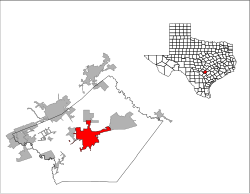Seguin, Texas
| Seguin, Texas | |
|---|---|
| City | |

|
|
 Location of Seguin, Texas |
|
 |
|
| Coordinates: 29°34′28″N 97°57′55″W / 29.57444°N 97.96528°WCoordinates: 29°34′28″N 97°57′55″W / 29.57444°N 97.96528°W | |
| Country |
|
| State |
|
| County | Guadalupe |
| Government | |
| • Type | Council-manager government |
| • Council-Manager |
Mayor Don Keil Ernest Leal Jeannette "Jet" Crabb Phil Seidenberger Tomas V. Castellon, Jr. Carlos Medrano Fonda Mathis Donna Dodgen Mark Herbold |
| • City Manager | Doug Faseler |
| Area | |
| • Total | 34.7 sq mi (89.8 km2) |
| • Land | 34.5 sq mi (89.3 km2) |
| • Water | 0.2 sq mi (0.5 km2) |
| Elevation | 522 ft (159 m) |
| Population (2010) | |
| • Total | 25,175 |
| • Estimate (2015) | 27,864 |
| • Density | 809/sq mi (312.2/km2) |
| Time zone | Central (CST) (UTC-6) |
| • Summer (DST) | CDT (UTC-5) |
| ZIP codes | 78155-78156 |
| Area code(s) | 830 |
| FIPS code | 48-66644 |
| GNIS feature ID | 1346881 |
| Website | www |
Seguin (/sᵻˈɡiːn/ sig-EEN) is a city in and the county seat of Guadalupe County, Texas, United States. As of the 2010 census the population was 25,175. By 2015, the population was estimated to be 27,864.
Seguin is one of the oldest towns in Texas, founded just sixteen months after the Texas Revolution. The frontier settlement was a cradle of the Texas Rangers and home to the celebrated Captain Jack Hays, perhaps the most famous Ranger of all.
Seguin was the home of Dr. John E. Park, who experimented in construction using concrete made from local materials. The nearly 100 structures—the courthouse, schools, churches, homes, cisterns, walls, etc.—made up the largest concentration of early 19th-century concrete buildings in the United States. About 20 of them remain standing.
The use of concrete largely ended when the railroad arrived in 1876, bringing cheap lumber and the equipment needed for brick-making. The town had five brickworks, and the wooden buildings of downtown were completely replaced with brick by the beginning of World War I.
For almost 100 years, the town was dependent on the rich surrounding farmland and ranches. Then an oil boom came just as the Great Depression was taking down other towns and cities. Seguin could raise enough tax money to match the federal grants for "make-work" projects. The New Deal transformed the city's public face with Art Deco-style City Hall, Courthouse, Jail, and fountain, as well as storm sewers, sidewalks, and three swimming pools (one for Anglos, one for blacks, one for Hispanics). The town commemorated its centennial by opening Max Starcke Park, with a golf course, a pavilion, picnic tables and BBQ pits along a scenic river drive, and a curving dam that created one of the most beautiful waterfalls in Texas.
...
Wikipedia
